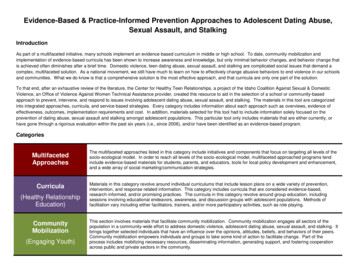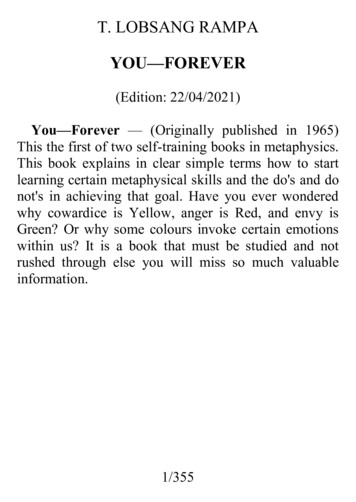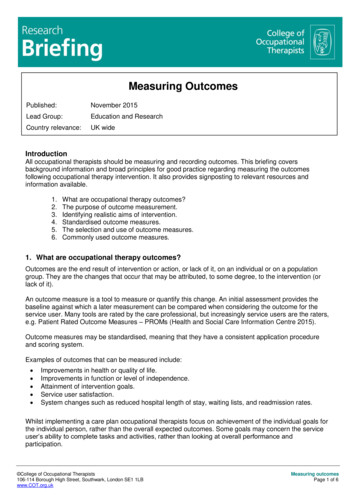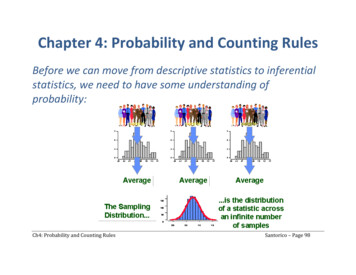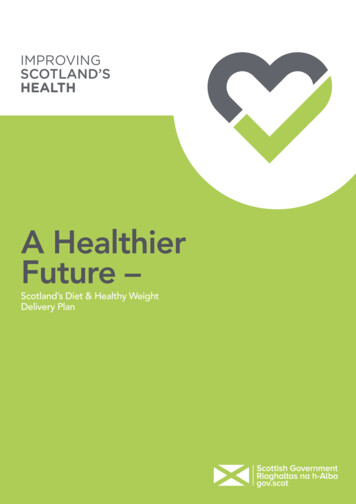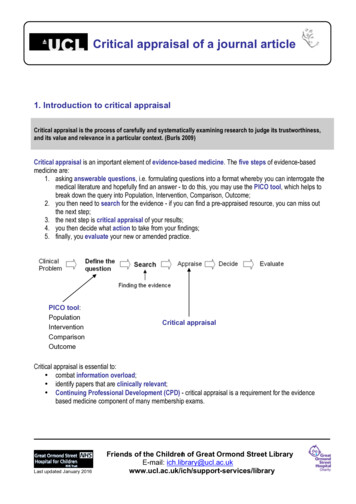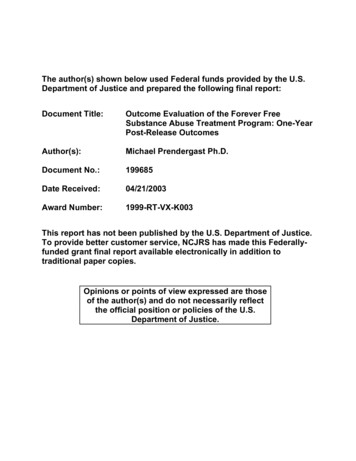
Transcription
The author(s) shown below used Federal funds provided by the U.S.Department of Justice and prepared the following final report:Document Title:Outcome Evaluation of the Forever FreeSubstance Abuse Treatment Program: One-YearPost-Release OutcomesAuthor(s):Michael Prendergast Ph.D.Document No.:199685Date Received:04/21/2003Award Number:1999-RT-VX-K003This report has not been published by the U.S. Department of Justice.To provide better customer service, NCJRS has made this Federallyfunded grant final report available electronically in addition totraditional paper copies.Opinions or points of view expressed are thoseof the author(s) and do not necessarily reflectthe official position or policies of the U.S.Department of Justice.
p R GV” wt i l j ’v’ OFNational Criminal Justrce Reference Service (NCJRS)I , . .IeBGX6000I‘.&-Rockvilie, MD 20849-6000.-I- -- L.An Outcome Evaluation of the Forever Free Substance AbuseTreatment Program:One-Year Post-Release OutcomesI9?6g5Michael Prendergast, Ph.D.Principal InvestigatorElizabeth Hall, Ph.D.Project DirectorJean Wellisch, Ph.D.Project ConsultantFinal Report to the National Institute of JusticeGrant # 1999-RT-VX-KO03December 2001Revised July 2002Drug Abuse Research CenterUCLA Integrated Substance Abuse Programs11050 Santa Monica Blvd., Suite 150Los Angeles, CA 90025Phone: 3 10-3 12-0500Fax: 3 10-312-0559This document is a research report submitted to the U.S. Department of Justice. This report hasnot been published by the Department. Opinions or points of view expressed are those of theauthor(s) and do not necessarily reflect the official position or policies of the U.S. Department ofJustice.---n*-.--
Forever Free Substance Abuse Treatment ProgramOne-Year Post-Release OutconzesContents\. 111EXECUTIVE SUMMARY . IV1INTRODUCTION .BACKGROUND . 2ACKNOWLEDGEMENTS4RECENTDATAON WOMEN INMATES AND THEIRCHILDREN .SUBSTANCE-ABUSINGWOMEN OFFENDERS IN CALIFORNIA .Demographics .Children .Drug Use and Crime .PAROLE VIOLATORS AND RECIDIVISTS.PRIOR TREATMENTEXPEFUENCEOF WOMEN OFFENDERS IN CALIFORNIA .SUBSTANCE ABUSETREATMENTFOR WOMEN OFFENDERS: EFFICACY.25556677. 8RECENT STUDIES OF FOREVER FREE . 9DESIGN AND METHODS .11DESCRIPTION OF THE FOREVER FREE SUBSTANCE ABUSE TREATMENT PROGRAMSUBJECT SELECTION AND DATACOLLECTION PROCEDURE: INTAKE.DATACOLLECTIONPROCEDURE:FOLLOWUP PARTICIPANTS. . .Characteristics.Program Participation .PAROLEPERFORMANCE.DRUGU S E VATION AND TREATMENTATTENDANCE.1818192124282930RELATIONSHIPS WITH CHILDREN .32SERVICES NEEDEDAND RECEIVED DURINGPAROLE . 34PREDICTORS OF OUTCOME.37DISCUSSION AND RECOMMENDATIONS.LIMITATIONS.RECOMMENDATIONS AND DIRECTIONSFOR FUTURERESEARCH .APPENDIX .REFERENCESd:\betsy\foreverl\outcome report\forever free outcome report nij revisions.doc/6/18/02 pc52 7/25/02.11This document is a research report submitted to the U.S. Department of Justice. This report hasnot been published by the Department. Opinions or points of view expressed are those of theauthor(s) and do not necessarily reflect the official position or policies of the U.S. Department ofJustice.4550515355
Forever Free Substance Abuse Treatment ProgramOne-Year Post-Release OutcomesAcknowledgements\The research described in this report is supported by National Institute of Justice grant#1999-RT-VX-K003, and we are indebted to our N I J program coordinators, Laurie Bright and LauraWinterfield. We would like to thank the women who participated in the study, Forever Freecounselors and staff, and California Institution for Women staff members for their kind assistancein making our research possible. Special thanks go to David Chavez, Correctional Counselor 111;Richard Jeske and Angela Knox, former Forever Free Program Coordinators; and Efnest Jarman andKaren Johnson of the California Department of Corrections, Office of Substance Abuse Programs.We would also like to thank Lynn Brecht and Yan Cao for their assistance in producingstatistical results for this report, Meredith Patten for her assistance in producing the executivesummary, and Jane Chen, Cora Garcia, Susan Lee, and Caroline Potter for their assistance in dataentry and management.111This document is a research report submitted to the U.S. Department of Justice. This report hasnot been published by the Department. Opinions or points of view expressed are those of theauthor(s) and do not necessarily reflect the official position or policies of the U.S. Department ofJustice.
Forever Free Substance Abuse Treatment Program,One-Year Post-Release OutcomesAn Outcome Evaluation of the Forever Free Substance AbuseTreatment Program:One-Year Post-Release Outcomes\Executive SummaryThis executive summary highlights the background, design and methods, and findingsrelating to the outcome evaluation of the Forever Free Program located at the California Institutionfor Women in Frontera. The Forever Free Substance Treatment Program is an intensive residentialtreatment program for women inmates with substance abuse problems followed by voluntarycommunity residential treatment during parole. Study GoalsContrast the 12-month post-release outcomes of Forever Free participants with thoseof the comparison group with regard to parole performance, drug use, employment,and psychologicaI functioning.Examine differences between groups with regard to their relationships with theirchildren following release to parole (custody status and parenting). 'Examine service needs during parole for both groups.Determine outcome predictors for the whole sample and for Forever Freeparticipants (tested predictors included group status, age, ethnicity, primary drugproblem, criminal history, psychological functioning, level of therapeutic alliance,treatment readiness, and locus of control).The outcome evaluation reported here was funded by the National Institute of Justice (NIJ),under its Residential Substance Abuse Treatment (RSAT) Evaluation Program (1 999-RT-VX-K003).BackgroundDrug-dependent women pose a serious problem for criminal justice authorities for severalreasons:The proportion of women inmates has grown at a faster rate than that of men;Female prisoners have some needs that differ from those of male prisoners, requiringdifferent management and programming approaches that may contributedisproportionately to burdens on the system;Most jurisdictions do not have appropriate treatment programs for women, and treatmentservices often do not deal adequately with the underlying problems driving their criminalactivities; and,Because of relapse to drug use, failure on parole and recidivism in general is high.Although few controlled studies of the effectiveness of substance abuse treatment for womenin the criminal justice system exist, the extant studies show a small effect on criminal activity (mostother outcome variables have not been reported).Description of the Forever Free ProgramThe Forever Free Program began in 1991. It was developed and is currently being operatedby Mental Health Systems, Inc., under contract to the Office of Substance Abuse Programs of theCalifornia Department of Corrections (CDC). Between May 1991, when Forever Free began, andThis document is a research report submitted to the U.S. Department of Justice. This report hasnot been published by the Department. Opinions or points of view expressed are those of theauthor(s) and do not necessarily reflect the official position or policies of the U.S. Department ofJustice.
’e@*I* Forever Free Substance Abuse Treatment ProgramOne- Year Post-Release OutcomesDecember 3 1, 1998, 2,017 women graduated and were released to parole. At the time of the study,treatment was six months in duration and the women attended treatment for four hours per dqy inaddition to their eight-hour work assignment in a prison job or education program. A new cohortof about 30 women joined the program every six weeks.As a modified therapeutic community with a cognitive-behavioral curriculum stressingrelapse prevention, Forever Free’s approach presented addiction as a disease. Using the Gorskicurriculum, the program taught clients to identify symptoms and use skills and strategies for dealingwith post-acute withdrawal (relapse prevention). In establishing the Forever Free Program, CDC hadthe following objectives:Provide in-prison treatment with individualized case planning and linkages tocommunity-based aftercare;Provide an in-prison program that includes a range of services to meet the psychosocialneeds of participants, including counseling, group interaction, 12-step programs,educational workshops, relapse prevention training, and transition plans to refer clientsto appropriate community aftercare;Reduce the number of in-prison disciplinary actions;0Reduce substance abuse among participants;Reduce recidivism.In order to achieve these objectives, the Forever Free Program offered an array of servicesand programs, among them assessment, treatment planning, individual and group substance abusecounseling, parole planning, 12-step groups, and urine testing. In addition, the 26-week schedulecontained a curriculum that emphasized relapse prevention, cognitive-behavioral skill building, andwomen’s issues. Sessions devoted to women’s issues covered a number of subjects important towomen’s recovery, including self-esteem and addiction, anger management, assertiveness training,healthy versus disordered relationships, abuse, post-traumatic stress disorder, co-dependency,parenting, and sex and health. Since the intake phase of the study was completed, in response tochanges in CDC policy, the program was redesigned to conform more closely to the therapeuticcommunity model. It also has been changed from a six-month to a four-month program (since mostclients are short-term parole violators).Design and MethodsSubject Selection and Data Collection Procedure: Treatment Clients. All clients entering theForever Free program between October 1997 and June 1998 were invited to participate in the study.(Baseline recruitment took place under our process evaluation of Forever Free, supported by NIJgrant 97-RT-VX-K003.) Of the 149 eligible clients, 15 (10%) declined to participate and anadditional 15 (10%) were unavailable for study intake due to illness, court appearances, family visits,or other reasons, leaving a total of 119.Comparison Clients. Women attending Life Plan for Recovery, an eight-week (three hourper day) substance abuse education course, were selected as the comparison group for the studybecause of their similar backgrounds and voluntary participation in a low-intensity substance abuseeducation program. Those enrolled in the course between April and November of 1998 were invitedto participate. Of the 105 eligible women, 8 declined to participate and one was removed from thesample because she subsequently entered the Forever Free program and became part of that sample,leaving a total of 96 comparison subjects.On most measures, there was no statistically significant difference between the treatment andcomparison groups. The women in both groups were about 35 years of age, averaged about 16 priorarrests and 8 prior incarcerations, and, at intake, most were incarcerated for a drug offense. Inaddition, they were poor, ethnically diverse, undereducated, and worked in low paying jobs.VThis document is a research report submitted to the U.S. Department of Justice. This report hasnot been published by the Department. Opinions or points of view expressed are those of theauthor(s) and do not necessarily reflect the official position or policies of the U.S. Department ofJustice.,
Forever Free Substance Abuse Treatment ProgramOne- Year Post-Release Outcomes“*IData Collection Procedure: Follow Up. Follow up took place approximately one year afterrelease from prison. We were able to locate and interview 84% of our intake subjects at folloy-up(from both the treatment and comparison groups). Using the CDC Offender-Based InformationSystem (OBIS), we obtained reincarceration information on all study participants.Outcome Measures. In addition to collecting background information on the subjects, weutilized standardized instruments to collect information on the subjects’ behavior since release inthe following domains:0drug and alcohol use0criminal activity, arrests, and reincarcerations0relationship with their children0tobacco use0substance abuse treatment0vocational training0services needed and received0treatment motivation0social support0psychological status0drug-related locus of controlData Analysis. Data were analyzed using SAS and SPSS chi-square and t-test procedures.We used logistic regression (SPSS) to control for participants’ baseline characteristics in analyzingall participants’ reincarceration, drug use, alcohol use, and employment status at follow-up. Becausewe had more background information at baseline on the treatment group, we used additionalvariables in our logistic regression analysis of this group. Survival analysis was performed using theKaplan-Meier log-rank statistic (SPSS). We used Cox regression to examine the relationshipbetween time to reincarceration and covariates identified in our logistic regression analysis (SPSS).aFin dingsOur study demonstrates the effectiveness of the Forever Free program for women offendersand provides data on outcome domains of great importance to women, but not generally availablein the literature (e.g., employment, relationships with children, and services needed and received).1000)ULForever FreeComparison4020Arrested since Convicted sincereleasereleaseIncarceratedsince releaseCriminal justice measures: Forever Free participants perform better0Criminal Justice Measures. According to self-report data, Forever Free program participantswere arrested andor convicted at a significantly lower rate than those of the comparison group. Also,a lower percentage of Forever Free participants were incarcerated (although this did not reachstatistical significance).viThis document is a research report submitted to the U.S. Department of Justice. This report hasnot been published by the Department. Opinions or points of view expressed are those of theauthor(s) and do not necessarily reflect the official position or policies of the U.S. Department ofJustice.
Forever Free Substance Abuse Treatment ProgramOne-Year Post-Release OutcomesA separate analysis for the full sample showed the effect that residential treatment withinprison (Forever Free) and after release had on incarceration one year after release. As treatmentexposure increased from no residential treatment in prison or on parole to treatment both in prisonand during parole, reincarceration significantly decreased.6040200Comparison, Comparison, Forever Free, Forever Free,resid. txno resid. txresid. txno resid. tx(N 27)(N 54)(N 47)(N 52)Percent reincarcerated: Prison treatment' parole treatment best outcomeDmc.73.6C.-0r0aI@#-III:r'-.4.3.?.2LI II-.5g-m54111:-4 I I 7*#I ITCIIIIIComparisonForever er of days before first incarcerationForever Free treatment significantly delays reincarceration0Using California Department of Corrections data, survival analysis showed a significantdifference between the groups in days to first reincarceration, with Forever Free women fairingmuch better. At six months after release (180 days), approximately 40% of the comparison grouphad been reincarcerated while less than 15% of the Forever Free participants had beenreincarcerated. At one year post-release, over 60% of the comparison women had been returned toCDC custody in contrast to approximately 40% of Forever Free women. Controlling for backgroundvariables (Cox regression analysis), we found that age and group status were predictors of time toreincarceration, with older subjects and Forever Free participants having delayed reincarceration.viiThis document is a research report submitted to the U.S. Department of Justice. This report hasnot been published by the Department. Opinions or points of view expressed are those of theauthor(s) and do not necessarily reflect the official position or policies of the U.S. Department ofJustice.
.,Forever Free Substance Abuse Treatment ProgramOne-Year Post-Release Outcomes"*,0 Forever FreeComparisonAny drug use since Any 'drug use 30releasedays beforeinterviewLower levels of drug use among Forever Free participantsDrug Use. A significantly lower percentage of Forever Free participants reported using anydrug since release from CIW and in the 30 days before the follow-up interview. Alcohol use sincerelease was also significantly lower for the Forever Free group. Those who attended treatment afterrelease were less likely to use drugs in the thirty drugs prior to their follow-up interview. Also, thecomparison group reported spending more money on drugs and alcohol during the 30 days prior tothe interview than the treatment group. Nearly 8 in 10 women in both groups smoked, and themajority of these reported wanting to try to a stop smoking program.08020)60-0Forever Free0LComparison40-200-pEmployed at time of follow upHigher level of employment among Forever Free participants(1)Employment. Two-thirds of Forever Free participants were employed at the time of thefollow-up interview compared to less than half of the comparison group. Residential treatmentduring parole was key to improving all subjects' chances of being employed.Psychological Functioning. While participating in the Forever Free program, participants'overall psychological functioning improved, and, for the most part, they were able to maintain their.VlllThis document is a research report submitted to the U.S. Department of Justice. This report hasnot been published by the Department. Opinions or points of view expressed are those of theauthor(s) and do not necessarily reflect the official position or policies of the U.S. Department ofJustice.
I*.I4Forever Free Substance Abuse Treatment ProgramOne-Year Post-Releqse Outcomesimproved functioning during the year following release. At follow-up, Forever Free participants hadsignificantly better psychological functioning than the comparison group.Treatment Motivation and Treatment Attendance. We looked at treatment motivation andattendance at follow-up for both the treatment group and the comparison group. The comparisongroup felt that drugs were a greater problem and had a greater desire for help than the treatmentgroup. Forever Free participants felt that they had greater control over their drug-use behaviors. Inanalyses on the relationship between treatment motivation and treatment received during follow-up,those who received treatment after parole had higher mean scores on the Desire for Help subscalethan those who did not attend aftercare.Relationships with Children. The vast majority of women in the study had children and twothirds had children under 18 years old. Of those with minor children, over half had custody of atleast some of their children. In contrast with the comparison group, a larger number of Forever Freewomen had custody of all of their children. We found significant differences at follow-up betweenthe Forever Free and comparison groups in children’s living situations. Forever Free women weremore likely to have a child living with them, while the children of the comparison group were morelikely to live with a grandparent. As a result, Forever Free women spent significantly more timeengaged with their children in various activities in the home. Forever Free women also ratedthemselves as doing well in their parenting, better than the self-rating of the comparison group.Sewices Needed and Received During Parole. Women in the comparison group had greaterservice needs than the Forever Free group, but the comparison group received services at a lowerrate than the Forever Free group. The greatest unmet need for both groups was in the area ofvocational and educational services, with nearly 40% reporting that they did not receive thevocational services they needed.Outcome Predictors. Controlling for covariates in our logistic regression analysis, we foundthat group status did not predict reincarceration. However, our Cox regression analysis of time toreincarceration, which also controlled for covariates, found that group status and age werepredictive of time to reincarceration (i.e., Forever Free participants and older participants haddelayed reincarceration). Of the two analytic methods, the Cox regression analysis is the moresensitive measure. Forever Free participants were also less likely than the comparison group to usedrugs during the year following release. If a participant was older or reported cocaine as her primarydrug, she was less likely to use alcohol during the year following her release. Significantly moreForever women were employed at follow-up. Also, methamphetamine users were more likely to beemployed than heroin users and those with more education were more likely to be employed. Whenlooking at the logistic regression results of Forever Free participants only, we found that thosewomen who attended residential treatment during parole were nearly 15 times more likely to beemployed at follow-up.\a,0Recommendations and Directions for Future ResearchIt is clear from this report and from past studies of Forever Free that treatment after releaseis extremely important to success during parole. For instance, we reported in this study that womenwho attended community residential treatment were much more likely to be employed at follow up.In light of this evidence, we recommend that criminal justice system policy-makers encourage, ifnot mandate, community aftercare for women participating in prison-based treatment.It is likely that the high levels of unmet service needs documented in this report contributedin some part to the failure of those women who were returned to custody during follow up. Wesuggest a policy change that requires needs assessment for women about to be released and providesa linkage to community-based programs that address women parolees’ service needs through direct1xThis document is a research report submitted to the U.S. Department of Justice. This report hasnot been published by the Department. Opinions or points of view expressed are those of theauthor(s) and do not necessarily reflect the official position or policies of the U.S. Department ofJustice.,
Forever Free Substance Abuse Treatment ProgramOne-Year Post-Release Outcomesservice delivery. More research on the impact of post-release services on long-term outcome isneeded.\.RecommendationsStrongly encourage or mandate community aftercareRequire a service needs assessment prior to paroleLink Forever Free parolees to community servicesProvide vocational training to improve income status of women and their childrenUndertake additional research on cognitive-behavioral treatment in prisonsettingsUndertake additional research on the impact of post-release services on longterm outcomeaThis study demonstrates the effectiveness of the cognitive-behaviorally-oriented ForeverFree program. Most research on prison-based treatment involves programs based on the therapeuticcommunity model. We recommend that additional research be undertaken on the effectiveness ofpsychoeducational or cognitive-behavioral models of treatment in contrast to therapeutic communitytreatment within criminal justice settings. In addition, therapeutic community treatment programstypically are 12 months in length. That the Forever Free program, which was only 6 months induration at the time of the study, was able to demonstrate its effectiveness may indicate thatconsiderable cost savings could be achieved. Additional research needs to be undertaken on thecomposition and duration of programs for women in the criminal,justice system.This study presents evidence of better parenting outcomes for the women who participatedin Forever Free. While this is likely due to the effects of treatment, we cannot rule out the possibilityof baseline differences in the groups. Because improving the status of children of CJS-involvedwomen is so important to breaking the cycle of drug use, crime, and poverty, there is great need formore research on this question.Despite the limited vocational training Forever Free women received in prison, they weremore likely than the comparison women to be employed at follow up. However, their income levelswere low, putting them at the poverty line if they had two children at home. In addition, we foundthat the study participants’ greatest unmet service needs involved vocational training andemployment assistance. Because, as the law now stands, those convicted of drug crimes are noteligible for training through welfare-to-work programs, vocational training readily available to thosein the criminal justice system is essential to improving the income status of CJS-involved womenand their families.Limitations. Although the treatment group and comparison groups were very similar, ourdata may be limited due to our inability to randomly assign subjects. Also, due to a limited budget,we were unable to capture baseline data for the comparison group on certain scales (treatmentmotivation, psychological functioning, etc.), which, had we had such data, may have enabled us tobetter correct for any group differences. Furthermore, since this was an evaluation of a singleprogram, our ability to generalize to other women’s programs in the criminal justice system may belimited.AThis document is a research report submitted to the U.S. Department of Justice. This report hasnot been published by the Department. Opinions or points of view expressed are those of theau
for Women in Frontera. The Forever Free Substance Treatment Program is an intensive residential treatment program for women inmates with substance abuse problems followed by voluntary community residential treatment during parole. Study Goals Contrast the 12-month post-release outcomes of Forever Free participants with those




